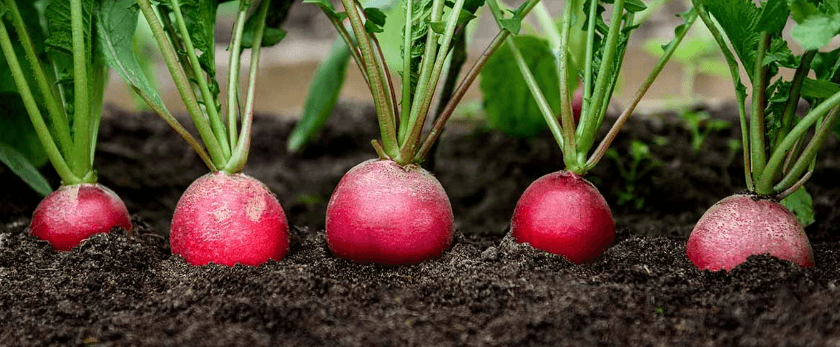Are you looking to add some fresh, homegrown produce to your meals? Look no further than radishes! These crunchy, peppery root vegetables are easy to grow and can be harvested in just a few weeks. Plus, they are packed with nutrients and can add a pop of color to any dish. In this article, we'll cover everything you need to know about growing radishes in a sustainable and eco-friendly way.
Why Grow Radishes?
Before we dive into the specifics of growing radishes, let's talk about why you should consider adding them to your garden. Here are a few reasons why radishes are a great addition to any sustainable garden:
- Fast-growing: Radishes are one of the fastest-growing vegetables, with some varieties ready to harvest in just 3-4 weeks. This means you can enjoy fresh, homegrown produce in a short amount of time.
- Low maintenance: Radishes are relatively low maintenance and don't require a lot of attention or care. This makes them a great option for beginner gardeners or those with limited time.
- Nutrient-rich: Radishes are a good source of vitamin C, folate, and potassium. They also contain antioxidants and fiber, making them a healthy addition to your diet.
- Versatile: Radishes can be eaten raw, cooked, or pickled, making them a versatile ingredient in the kitchen. You can add them to salads, sandwiches, stir-fries, and more.
- Companion plant: Radishes are a great companion plant for other vegetables, as they can help repel pests and attract beneficial insects to your garden.
Now that you know why radishes are a great addition to your garden, let's dive into how to grow them sustainably.
How to Care for Radishes
Watering
Radishes need consistent moisture to grow, but they don't like to be waterlogged. The key is to keep the soil evenly moist, but not soggy. You can achieve this by watering deeply once or twice a week, depending on the weather and soil conditions. Avoid overhead watering, as this can lead to fungal diseases. Instead, water at the base of the plant to keep the leaves dry.
Light
Radishes prefer full sun, but they can also tolerate partial shade. If you live in a hot climate, providing some shade during the hottest part of the day can help prevent the plants from bolting (producing flowers and seeds prematurely).
Soil
Radishes grow best in loose, well-draining soil with a pH between 6.0-7.0. If your soil is heavy or clay-like, consider adding compost or organic matter to improve drainage and fertility. You can also grow radishes in containers filled with potting mix, as long as the container has good drainage holes.
Fertilizer
Radishes don't require a lot of fertilizer, but adding some organic matter or a balanced fertilizer (such as 10-10-10) before planting can help provide the nutrients they need to grow. Avoid using high-nitrogen fertilizers, as this can lead to leafy growth instead of root development.
Pruning
Radishes don't require pruning, but you can thin them out if they are growing too close together. This will give the remaining plants more room to grow and develop larger roots. You can also harvest the leaves of radishes and use them in salads or stir-fries.

What is the Best Time to Grow Radishes?
Radishes are a cool-season crop and can be grown in both spring and fall. In warmer climates, you can also grow them in the winter. The key is to avoid planting them in the heat of summer, as this can cause them to bolt and become bitter. You can also stagger your plantings every 2-3 weeks to ensure a continuous harvest throughout the growing season.
Common Problems with Radishes
While radishes are relatively easy to grow, they can still face some common problems. Here are a few issues you may encounter and how to address them:
- Pests: Radishes can be susceptible to pests such as flea beetles, root maggots, and aphids. You can prevent these pests by using row covers or planting radishes with companion plants that repel them, such as marigolds or garlic. If you do notice pests, you can try using organic pest control methods such as neem oil or insecticidal soap.
- Diseases: Radishes can also be affected by diseases such as powdery mildew, root rot, and clubroot. To prevent these diseases, make sure to rotate your crops and avoid planting radishes in the same spot every year. You can also practice good garden hygiene by removing any diseased plants and keeping the garden clean.
- Bolting: As mentioned earlier, radishes can bolt (produce flowers and seeds) prematurely if they are exposed to high temperatures. To prevent this, make sure to plant them in the appropriate season and provide some shade during the hottest part of the day.
Sustainable Disposal Methods
Once you have harvested your radishes, it's important to dispose of any leftover plant material in a sustainable way. Here are a few eco-friendly options for disposing of your radish plants:
- Composting: You can add radish plants to your compost pile, as they are rich in nutrients and will help create a healthy compost for your garden.
- Mulching: You can also chop up the plant material and use it as mulch in your garden. This will help retain moisture and suppress weeds.
- Donating: If you have excess radishes, consider donating them to a local food bank or community organization. This will help reduce food waste and provide fresh produce to those in need.
Conclusion
Growing radishes is a great way to add fresh, homegrown produce to your meals while also practicing sustainable gardening methods. By following the tips and techniques outlined in this article, you can grow healthy, delicious radishes in an eco-friendly way. Remember to water consistently, provide adequate light and nutrients, and address any common problems that may arise. And don't forget to dispose of your radish plants in a sustainable way to complete the cycle of sustainability. Happy gardening!










